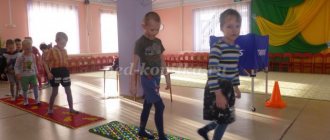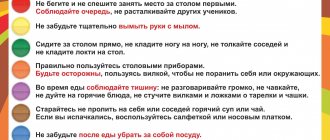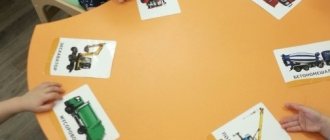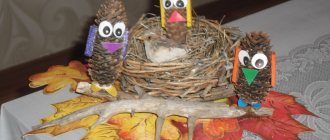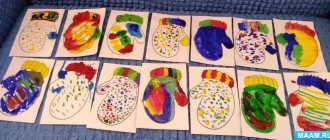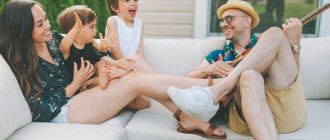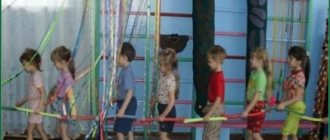Winter physical education fun for young children
Summary of winter physical education entertainment for young children “Bunny visiting the children”
The abstract is addressed to teachers working with young children and physical education instructors in preschool educational institutions. The subject matter of the lesson and program content correspond to the age characteristics of children from one and a half to two years of age.
Goal: maintaining and strengthening the health of young children. Objectives: • Practice jumping on two legs in place and in long jumps from a place with a push with two legs; • Form ideas about winter as a season; • Inspire joy from joint physical activity with adults and children. Equipment: “Bunny” toy, large snowflakes (diameter 10 cm), small snowflakes according to the number of children, basket, snowballs according to the number of children.
Progress of the entertainment:
Introductory part: The instructor shows the children a toy - a white bunny, and invites them to examine it. Tells the children that winter has come and the bunny has changed his fur coat from gray to white. Invites the children to show how the “bunny” was going to visit the children. Coordination of speech with the movement “The white bunny is washing his face” Children perform the movements as shown by the instructor in accordance with the text of the poem: The white bunny is washing his face, apparently getting ready to visit, Wash his nose, wash his tail, Wash his ear, wipe it dry, And jump to visit the children!
The instructor shows the children a basket with snowflakes, says that a bunny brought the basket to the children as a gift. The instructor lays out a circle of large “snowflakes”, the distance between them is 50 - 70 cm, and places a “bunny” toy in the center of the circle.
Invites children to show the “bunny” how beautifully they can walk. Walking in a circle is normal; “let’s step over the snowdrifts” with our hands on our belts - raising our knees high; crawling with support on your palms and knees; “bunnies jumping on the lawn” - jumping on two legs in place; “let’s run away from the fox” - easy running in a circle; walking. Forming in a circle according to the “snowflakes” landmarks. The main part of the outdoor switchgear: 1. “The sun is warming less and less”
- I.P.
- standing, legs together, arms along the body, 1 - raise your arms up through your sides, 2 - return to I.P. 4 times 2. “The frost is crackling outside the window”
- I.P.
standing, feet shoulder-width apart, hands on waist - bend to the right (left), 2 - return to I.P. 4 times 3. “In the snow woman’s yard”
I.P., the same, 1 - turn right (left), 2 - return to I.P.
4 times 4. “The carrot nose has turned white”
I.P.
feet width apart, arms along the body, 1 - sit down, hide your nose with your palms, 2 - return to IP. 4 times 5. “Well, there are miracles in the river, the water has become solid”
- I.P.
feet width apart, hands on waist. Jumping on two legs in place 8 jumps alternating with walking. 2 times. The instructor praises the children. Places snowflakes in one line, the distance between them is 50 cm, suggests first stepping over and then jumping over the “snowflakes”. ATS: 1. Walking, stepping over “snowflakes” with a high knee lift. The instructor pays attention to the children’s posture. 2. Jumping on two legs over “snowflakes” with a push with both legs. The instructor encourages children to push off vigorously and land softly. Outdoor game “Snowflakes and Frost” The instructor invites the children to take one snowflake in their hand. At the command of the wind, children run in one direction. On the command “Frost - hide your nose,” they crouch down and hide behind a snowflake. The game is repeated 2-3 times. Final part Low mobility game “Collect snowballs into a basket” The instructor scatters “snowballs” from a basket and asks the children to help the bunny collect snowballs into the basket. 2 times. Game exercise “It’s frosty outside” Children perform the movements shown by the instructor according to the text of the poem: And it’s frosty outside, Well, everyone grabbed their nose, Turned their nose, turned their nose, warmed them up, warmed them up!
There is no need for us to beat our heads, Everyone quickly grabbed their ears, Ears - ears turned, warmed - warmed up! They clapped their hands, stomped their feet, spun, twirled, warmed up - warmed up! The instructor, on behalf of the “bunny,” thanks the children for the fun games and says goodbye to the children.
We recommend watching:
Scenario of winter play leisure for children from 2 years old Winter entertainment in the first junior group Winter entertainment in the junior group of kindergarten. Scenario Scenario of physical education entertainment for children of the younger group
Similar articles:
Summary of a winter walk in the junior group of kindergarten on the topic: “Birds in winter”
Summary of a game lesson for young children on the topic: Winter
Outdoor winter games for children, 2-4 years old
MAGAZINE Preschooler.RF
Summary of educational activities for physical development in the 1st junior group. Theme "Visiting the Bunny"The notes were compiled by teacher Olga Aleksandrovna Turova.
Goal: to develop children’s interest and value attitude towards physical education, harmonious physical development.
Objectives: continue to teach children to walk in a column one after another, practice walking on their toes and heels, maintaining balance. Improve your walking skills in a limited area, practice stepping over objects (sticks), and strengthen your skills of crawling on all fours under an arch. Foster a sense of teamwork.
Integration challenges.
Communication: in the outdoor game “The Little White Bunny Is Sitting,” continue to teach how to act according to the words of the text and solve riddles.
Health: instill a desire for a healthy lifestyle and physical exercise.
Cognition: through motor activity, introduce children to wildlife, animal habits, and form an idea of primary colors.
Preliminary work: outdoor games, play exercises, morning exercises.
Equipment: toy bunny, wolf, collar (2 pieces), walking sticks (6 pieces), ribbed path.
Progress of the lesson.
Educator. Children, today we will go to visit you. Guess the riddle and then you will find out who we are going to.
Long ear ball of fluff Jumps deftly loves carrots.
Children. Bunny.
Educator. That's right, we'll go to the bunny, everyone follow me and let's go.
(Normal walking)
The legs walked straight along the path. (Walking on toes and heels) We will walk on our toes, and now on our heels. Look all around how the kids are walking. (Running after each other) Our legs are running, running along the path,
And until we get tired, we won’t stop running. (Regular walking, formation in a circle) Again our legs walk along the path. And now, honest people, join the round dance.
Part 2 (General developmental exercises).
1 I.p. Standing, legs slightly apart, arms down.
We raise our hands higher and then lower them
2 I.p. Standing, legs slightly apart, hands on the waist (turns left and right)
Look on the lawn to see if you can see a bunny's house.
3 I.p. Legs slightly apart, squat, clap in front of you.
The children began to squat and bang their palms.
4 I.p. Standing, legs slightly apart, arms down.
Jumping alternating with walking. And now you need to jump, quickly, fun and friendly. We'll walk on the spot
Friendly, fun and together. Main types of movements (flow method)
Educator. We've done our exercises, and now we need to continue to go to Bunny.
(stepping over sticks)
To find the bunny you need to go through the branches. We step through the branches and raise our legs higher.
(Crawling through the gate)
Climb into the hole and bend your back.
(Walking along a ribbed path)
We will go along the path and visit the bunny.
Educator. These are great guys, we can go to Bunny. And here comes Bunny.
Bunny. Hello my friends, I've been waiting for you, it's time to play.
(Active game “The little white bunny is sitting.” )
Educator. Children, the bunny is very tired and hungry, and we promised to give him a treat.
Look, we have geometric shapes here, find the square and go to it, what is hidden here?
Children. Carrot.
Educator. Now find the triangle and go to it, what is hidden behind the triangle?
Children. Cabbage. (We treat the Bunny with vegetables)
Educator. Who did we visit today? Did you enjoy our trip?
(Children's answers)
Educator. And now it’s time for us to return to the group, let’s say goodbye to Bunny.
I take the children to the group.
| Next > |
Outdoor physical education activities for children 2-3 years old
Complex No. 1 (1-2 weeks of September).
Program objectives: Teach children to walk and run in small groups, following the teacher. Develop the ability to act on a signal. Learn to walk between two lines (limited area), maintaining balance. Practice jumping in place on two legs.
1. Walking and running in small groups in a straight direction.
The game “Let’s go visit” - the children are walking, “it’s raining!” run to their houses (2 times).
2. -Walking between two lines in a column (drawn on the asphalt)
-P/n “Run to me” (the teacher stands on the opposite side of the children and says the words “run all of you to me”) is repeated 3-4 times.
-exercise “Bunny”. 10-15 jumps alternating with walking in place (3-4 times)
3. Walking in a flock behind the teacher around the daycare center; the teacher may have a plot character in his hands.
Complex No. 2 (3-4 weeks of September).
Program objectives: Teach children to walk and run as a whole group according to the symbols following the teacher, consolidate the ability to jump in place on two legs. Learn to maintain starting positions during game exercises.
1. Walking and running as a whole group following the teacher along the path.
2. Game exercises.
- “Show your palms.” I.p. standing with your feet hip-width apart, your arms at your sides. Raise your hands forward, say “here”, return to IP (4p)
- “Show your knees.” I.p. standing with your feet shoulder-width apart, hands on your belt. Bend forward and place your palms on your knees, say “here”, return to IP (4p)
— Jumping on 2 legs in place, alternating with walking in place (2p)
3. P/n “Catch the ball.” The teacher rolls the ball in one direction, the children catch up with it, then in the other direction. (2p)
4. Walk in a flock behind the teacher, he may have a ball in his hands.
Complex No. 3 (1-2 weeks of October).
Program objectives: To familiarize children with walking and running in a column behind the teacher. Learn to do the exercises simultaneously with the teacher: sit down, clap in front of you. Develop the ability to respond to a signal and run in all directions.
1. Walking and running in a column.
2. Exercises:
- “Clap” I.p. standing, arms down along the body. Bring your hands forward, clap in front of you, return to IP (4p)
- “Squats” I.p. too, hands on the belt. Squat down, touch your knees with your palms, stand up, return to standing position (4 p).
- “Jumping” on 2 legs in place, alternating with walking (2p)
3. P/i “Sparrows and the cat” (Children stand in circles, an adult cat squats to the side, to the words “the sparrows flew” the children spread their arms to the sides “flapping their wings” and run in all directions, the cat wakes up and shouts “meow” ", runs after the children, and the children run away into the houses) (2p)
4. Walk in a column behind the teacher one at a time.
Complex No. 4 (3-4 weeks of October).
Program objectives: Teach children to walk and run in circles after the teacher. Learn to maintain stable balance while performing exercises. Develop orientation in space, respond to signals
.
- Walking and running in circles.
- Exercises:
- “Birds.” I. p. standing, legs slightly apart, hands behind the back, 1- arms to the sides, wave them: “chick-chirp”, 2- return to I. p. (4p)
- “The clock is striking.” I.p. legs apart, hands on the belt. 1-tilt right - left, say “boom”, 2-p. (4 r)
3. P/n “Find your house.” Children stand behind the line, at the words “let’s go for a walk” the children run away in different directions, at the signal “home” the children run to the “house” (2p)
-P/i “My funny ringing ball” (2p)
4. Walking in a column one at a time, the teacher may have a flag in his hands.
Complex No. 5 (1-2 weeks of November).
Program objectives: Teach children to stop when the teacher gives a signal while walking and running. Develop coordination of movements. Learn to run after each other without overtaking, and quickly respond to a signal in the next place.
- Walking and running in a column one at a time, stopping at the teacher’s signal.
- Exercises:
- “Mill” I.p. feet width apart, arms along the body. Swing both arms back and forth, return to IP (3-4 r)
- “Kolobok” I.p. the same, hands on the belt. Sit down, clasp your knees with your hands, stand up, etc. (3-4 r)
3. P/i “Train” (children line up in a column one at a time, the first in the column is a steam locomotive, the rest are carriages, when moving slowly they say “chu-chu-chu”, “the train is approaching the station”, the children stop) (2p ).
-P/i “Hen and Chicks” (2р)
4. Low mobility game “Guess who’s screaming?” (the teacher imitates the sound of the animal with his voice, and the children guess and depict the habits of this animal).
Complex No. 6 (3-4 weeks of November).
Program objectives: Strengthen the ability to walk and run in a circle. Develop balance and coordination of movements, the ability to quickly respond to a signal.
- Walking and running in circles.
- Exercises:
- “Tumbler.” I.p. standing, hands on the belt, rock back and forth, rest after 4 swings. (3p)
- “Jumping” on two legs, alternating with walking in place. (5 r)
3. P/i “Run to the flag” (the teacher holds a flag in his hands, at the signal “Run to the flag” the children run to the teacher.) (2-3p)
-P/n “Mishka” (teacher is a bear, the children come up to him and say the words “Bear, bear, why have you been sleeping for so long? Mishka, Mishka, why are you snoring so much? Mishka, Mishka get up, Mishka, play with us!” Mishka wakes up and says, “Why did you sing songs to me, why did you wake me up?” The children run away, Mishka catches up) (2-3r).
4. Walking in a column behind the teacher.
Complex No. 7 (1-2 weeks of December).
Program objectives: Exercise children in walking and running in a column, changing walking and running according to symbols. Develop the ability to jump on two legs while moving forward. Develop response to signals, develop balance and correct posture when walking
- Walking and running in a column one at a time.
- -Walking and running between two lines (in line, children walk along one path and run along the other) (2p).
-Jumping on two legs moving forward.
3. P/i “Mice in the pantry” (mice children sleep in holes, the teacher cat falls asleep, the mice run into the pantry, “gnaw crackers” when going out for a walk, the cat wakes up, screams “meow,” the mice run into the pantry.)
(2-3r)
4. Sedentary game “Bubble”. Slow walking around the kindergarten.
Complex No. 8 (3-4 weeks of December).
Program tasks: Practice walking in a column one at a time, performing tasks as directed by the teacher, jumping according to symbols, walking along a winding path, developing attention.
- Walking in a column one at a time, completing the teacher’s tasks, running in all directions. (Children walk in a column one after another, complete tasks - we walk like “foxes”, “bunnies”, then run in all directions) 2 times.
- -Walking along a winding path one after another (3p).
-Jumping on a flat path.
3. P/i “Tram” (the teacher has flags of two colors in his hands, children stand one after another pretending to be a tram, run to the “green flag”, stand to the “red” flag) (3p).
4. Sedentary game “In an even circle.”
Complex No. 9 (1-2 weeks of January).
Program tasks: Continue to teach walking and running in all directions, squatting, maintaining balance, jumping, moving forward. Teach quick changes of movements.
1. Walking and running randomly.
2.Exercises:
- “Birds” I.p. feet width apart, hands below. Raise your arms to the sides, lower them, return to standing position (4 p).
- “Squats” I.p. too, hands on the belt. Sit down, return to standing position (4p)
-P/i “Along a level path” (“Along a level path, along a level path our feet walk: One, two, one, two. Over the pebbles, over the pebbles... Into the hole - bang!”... the children walk, to the words “on pebbles” - jump on two legs, moving forward, to the words “into the hole” - squat down, “climbed out of the hole” - the children rise. (2p)
-P/i “Shaggy Dog” (2p).
3. Walking in a column, one at a time, behind the teacher.
Complex No. 10 (3-4 weeks of January).
Program tasks: Learn to walk in pairs, strengthen running in all directions, practice jumping. Develop coordination of movements during squats, a clear change of movements (jumping - walking). Continue learning to respond to a signal
.
Develop imagination.
- Walking in pairs, running in all directions.
- Exercises:
- “Swing” I.p. legs slightly apart, arms down. Swing your arms back and forth, slightly springing your legs. When swinging we say “uh” (4p)
- “Ball” Jumping in place, alternating with walking (5 jumps 3 times).
-P/i “At the bear in the forest” (2-3r).
-P/i “Sparrows and the cat” (Sparrows are children, the cat is the driver, to the words “sparrows fly” the children run, flapping their wings, the cat wakes up “meow”, the children run away to the teacher’s house) (2-3r)
3. Sedentary game “Find a toy” (the teacher hides the toy in advance, the children walk around the playground and look for it).
Complex No. 11 (1-2 weeks of February).
Program tasks: strengthen walking one at a time, completing tasks, exercise running, jumping, develop physical qualities.
1. Walking and running in a column one at a time.
2. Exercises:
- “Start the engine” I.p. feet width apart, arms in front of the chest, elbows bent, fingers clenched into fists. Circular movements of the arms in front of the chest, one arm rotates around the other. (5p)
- “Hedgehog” I.p. legs slightly apart, hands behind back. Sit down, clasp your knees with your hands, stand up, put your hands behind your back, return to the IP (5p)
— Jumping on two legs, alternating with walking (5 jumps of 3p each)
-P/i “Shaggy Dog” (2р)
3. Walking in a column, one at a time, around the kindergarten.
Complex No. 12 (3-4 weeks of February).
Software tasks. Teach children to respond to the teacher’s signal. In outdoor games, reinforce the rules. Develop jumping ability and accuracy.
1. Walking and running in a column one at a time.
2. Exercises:
- "Merry sparrows and horses." Walking in a column, at the signal of the “sparrow” - the children stop and flap their wings. At the “horses” signal, the children gallop straight ahead.
- Game “Roll and Knock Down” Children stand in a line, they have balls, you need to knock down the pins with balls (2 times).
Game "Find your color". Children run scattered around the playground, at the teacher’s signal, they run up to their color flag (hoop)
(2-3 times).
- Game "Planes". Walking at a slow pace around the kindergarten.
Complex No. 13 (1-2 weeks of March).
Software tasks. Teach children to make movements with words. Reinforce walking on a limited surface.
1. Walking and running in a column one at a time.
2. Exercises:
- Game "We stomp our feet." Children make movements along with words.
We stomp our feet, we clap our hands, we nod our heads.
We raise our hands. We lower our hands, we give our hands.
And we run around and around and around.
- Exercise “We are clever guys.” Walking on a board, a limited surface, arms to the sides.
"From bump to bump." Jumping from hoop to hoop on 2 legs.
- Sedentary game “Bubble” (2 times). Walk at a slow pace behind the teacher.
Complex No. 14 (3-4 weeks of March).
Software tasks. Teach children to run between objects without touching them. Continue teaching children to jump on 2 legs, moving forward; roll the ball between objects.
1. Walking and running in a column one at a time.
2. Exercises:
- “Run, don’t hit me.” Walking and running between objects.
- Game "Roll the ball between objects." Roll the ball between cubes and objects.
Game "Jumping Bunnies". Children jump from one side of the playground to the other on 2 legs. Alternate with walking (2-4 times).
- Game "Carousel" (performed at a slow pace 2-3 times).
Complex No. 15 (1-2 weeks of April).
Software tasks. Continue to teach children to walk, stepping over blocks, maintaining balance; jump over a rope on 2 legs. Learn to hit the ball with 2 hands.
1. Walking and running in a column one at a time.
2. Exercises:
- Game "Even Step". Walking in a column one at a time, stepping over the cubes. Run after each other.
- “Throw the ball on the ground and catch it.” Hitting the ball on the ground with 2 hands
(10 times).
"Through the stream." Jumping on 2 legs over a rope. (5-6 times).
- Sedentary game “Pass the ball.” Passing the ball from hand to hand in a circle (try not to let the ball fall out of your hands).
Complex No. 16 (3-4 weeks of April).
Software tasks. Teach children to complete a task at a signal from the teacher. Develop reaction speed in children.
1. Walking and running in a column one at a time.
2. Exercises:
- Game "Starlings". Children are "starlings" running around the playground. At the signal, children run to the birdhouses “hoops” (towards the cubes).
- Game “Cucumber, cucumber” (children go to the “mouse” and say the words: cucumber, cucumber, don’t go to that end, the “mouse” lives there and will bite off your tail). The “mouse” is catching up with the children.
Game "Brave Mice". Climb under the cord, hands on knees (height 40 cm).
- Sedentary game “On a level path.” Walking behind the teacher on a limited surface or along a cord.
Complex No. 17 (1-2 weeks of May).
Software tasks. Teach children to hit, toss, throw the ball.
Strengthen slow running in all directions. Develop coordination in children.
1. Walking and running in a column one at a time.
2. Exercises:
- Game "Through the Swamp". Walking, stepping over objects. Running between objects.
- Ball game:
- throwing up with 2 hands;
- hitting the ball on the ground with 2 hands;
-throwing a ball through a rope (objects) from behind the head with 2 hands.
3. Sedentary game "Cars". Simulate the motion of driving cars scattered across the site without touching each other.
Complex No. 18 (3-4 weeks of May).
Software tasks. Continue to teach children to accurately follow the teacher’s commands; roll the hoop in a straight line; develop the eye and precision of movements.
1. Walking and running in a column one at a time.
2. Exercises:
- Game "Find yourself a match." Children walk around the playground; at the teacher’s signal, the children quickly look for a mate (you can use flags of different colors).
- Game "Roll the Hoop". Children stand in a line, the hoop stands on its edge, the children must roll the hoop as far as possible.
Game “Bear the Bear in the Forest” (2-3 times).
- Game "Complete the task." Children perform the task at the command of the teacher.
